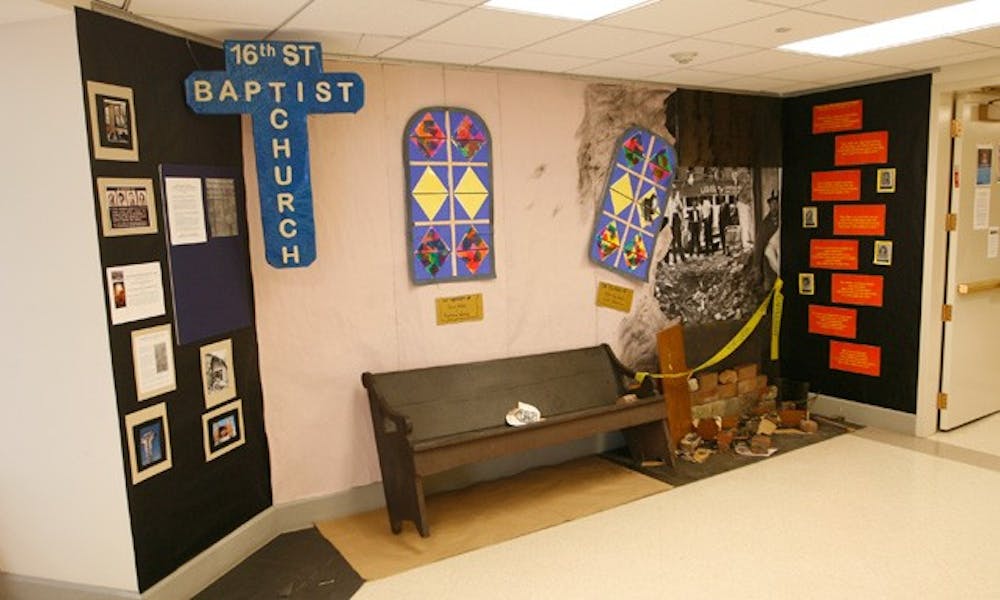“Mother dear, may I go downtown Instead of out to play, And march the streets of Birmingham In a Freedom March today?” “No, baby, no, you may not go, For the dogs are fierce and wild, And clubs and hoses, guns and jails Aren’t good for a little child.” “But, mother, I won’t be alone. Other children will go with me, And march the streets of Birmingham To make our country free.”
These are the opening lines of “Ballad of Birmingham,” imagining the conversation between the four little girls who perished in the 16th Street Baptist Church bombing in Birmingham, Ala. on Sept. 15, 1963 and their mothers. They also serve to frame the “Beauty for Ashes: Truth, Triumph and Tension” exhibit on display on the lower level of the Divinity School, which commemorates the bombing and celebrates Black History Month. Poet Dudley Randall wrote the ballad to express his rage and grief shortly after members of the Ku Klux Klan planted 22 sticks of dynamite in the basement of the Baptist Church. “Beauty for Ashes” draws on the same complex emotions—rage, grief—that Randall put into print in 1966.
“Life is hard, at times,” the exhibit quotes Martin Luther King Jr.’s eulogy for the four little girls: Denise McNair, Cynthia Wesley, Addie May Collins and Carol Robertson, “as hard as crucible steel.”
The exhibit is meant to probe the still-fresh wounds of a racialized and segregated past, its creators and organizers said. “It’s a history lesson, it’s a reflection on the work of the church in the Civil Rights Movement and it’s an invitation to think of how we fit into this picture,” said Joy Moore, associate dean for Black Church Studies and Church Relations. “We wanted for folks to encounter this moment of destruction, to see the irony of a burned out church in this kind of 3D reality.”
Conceptualized and created by members of the Black Seminarians Union and the New Creation Student Arts Group—both student groups in the Divinity School—over the course of a frenzied weekend, “Beauty for Ashes” is far from a typical professional exhibit. Courtney Bryant, a second-year Divinity student and the program coordinator for the Black Seminarians Union, is the first to admit that the Divinity school students who assembled the project are not artists in the typical sense of the word. “We used our ingenuity,” she said.
The mixed-media, three-dimensional mural—made of construction paper, cellophane, wood, bricks, papier mâché and other assorted materials—takes up three walls: one each for Truth, Triumph and Tension. The most provocative of the three seeks to recreate the wreckage of the bombing from the inside of the church looking out—ironically, to a storefront emblazoned with the name “Liberty.” Papier mâché windows and an actual church pew are the focal points of this section of the exhibit, but its emotional center is more easily missed. Buried in caution tape, charred brick, broken pieces of wood and brambles, a little girl’s shoe rests. Viewing the exhibit evokes the trauma the attack must have caused in 1963, marking a turning point in the Civil Rights Movement and preluding the passage of the 1964 Civil Rights Act. But for some, the bombing is a very real memory. For those with no recollection of the event, the exhibit recalls the attack to public memory.
“This is recent history,” Moore said. “This is something that happened in my lifetime and my parents’ lifetimes…. When we’re talking about having a black president—just 40 years ago, that was an impossibility. Part of this is just not to let that be forgotten.”
The walls adjacent to the church diorama host an homage to the accomplishments of the black church and an illustration of the tension between revolution and reconciliation that, at times, still colors race relations in the United States. There, visitors can share their reactions to the exhibit on a piece of red construction paper mimicking brick—rebuilding the broken Church, piece by piece.
“We wanted to really focus on the Baptist church as a lens through which to look at how the black church in America has contributed to the church universal and to the community at large,” Bryant said. “We also wanted to use the walls to provoke some questions about whether there is violence and revolution, whether there is a black church and a white church. Is the body of Christ broken?”
The act of putting the exhibit together, in itself, resembled an act of reconciliation for the exhibition’s organizers. The 20 Divinity school students—black and white—who worked late into the night, chipping in to supplement the $150 budget, are a testament to the progress that has been made since September 1963, Bryant and Moore said. The exhibit will remain on view until March 22.
“There’s hope here,” said Rebecca Turner, manager of the Cokesbury Bookstore, located across the hall from the exhibit, who said she was deeply moved by watching Divinity School students of all races assemble the murals. “We can acknowledge where we are and plan on moving forward…. We need to be reminded of the depth of the loss and the anger.”
Get The Chronicle straight to your inbox
Signup for our weekly newsletter. Cancel at any time.

